- eISSN 2353-8414
- Tel.: +48 22 846 00 11 wew. 249
- E-mail: minib@ilot.lukasiewicz.gov.pl
Satysfakcja konsumentów korzystających z innowacyjnych usług medycyny estetycznej w Polsce
Magdalena Ankiel1, Anna Kuczyńska2
1 Poznań University of Economics and Business, Al. Niepodległości 10, 61-875 Poznań, Poland
1 E-mail: magdalena.ankiel@ue.poznan.pl
ORCID: 0000-0003-2594-1600
2 E-mail: anna.kuczynska23@gmail.com
ORCID: 0000-0002-8932-0021
DOI: 10.2478/minib-2024-0023
Abstrakt:
Medycyna estetyczna to szybko rozwijająca się dziedzina, integrująca wiedzę z różnych specjalizacji medycznych w celu poprawy wyglądu fizycznego, podniesienia samooceny i poprawy jakości życia. Wyniki badania zaprezentowane w artykule dotyczą satysfakcji pacjentów z innowacyjnych usług medycyny estetycznej w Polsce, koncentrując się na czynnikach wpływających na wybór i skuteczność zabiegów. Wykorzystując dane od 745 pacjentów z dużych klinik w Polsce oraz przeprowadzając wywiady pogłębione z 20 lekarzami, badanie ocenia popularne procedury, wyniki po zabiegach oraz lojalność konsumentów przy użyciu techniki Net Promoter Score (NPS). Wyniki wskazują na wysoki poziom satysfakcji pacjentów, a zabiegi z toksyną botulinową typu A i wypełniacze na bazie kwasu hialuronowego są najczęściej wybieranymi zabiegami. Pacjenci podkreślali takie czynniki jak profesjonalizm, innowacje technologiczne i środowisko kliniczne jako kluczowe dla pozytywnych doświadczeń. Wyniki podkreślają znaczenie dostosowania oferty usług do oczekiwań konsumentów oraz wykorzystania zaawansowanych technologii do wzrostu zainteresowania konsumentów medycyną estetyczną. Przyszłe badania mają na celu rozszerzenie analizy na rynki międzynarodowe, dalej badając czynniki determinujące satysfakcję w różnych kontekstach kulturowych i ekonomicznych.
MINIB, 2024, Vol. 54, Issue 4
DOI: 10.2478/minib-2024-0023
Str. 91-109
Opublikowano 16 grudnia 2024

Satysfakcja konsumentów korzystających z innowacyjnych usług medycyny estetycznej w Polsce
1. Introduction
The pursuit of beauty is as old as mankind – throughout history, people have tried to improve their attractiveness and enhance their beauty. Aesthetic medicine, often considered as ancient as medicine itself (Krueger et al., 2013), traces its roots back to early civilizations. The ancient Egyptians, for instance, used oils, salt, alabaster, and milk to aesthetically improve the skin of their body and face (Brody et al., 2000). Nowadays, with rapid technological advancements and ongoing developments in medical science, aesthetic medicine offers patients/clients the possibility of seemingly eternal youth and an ideal figure (Napiwodzka-Bulek, 2017). These modern methods provide women as well as men the opportunity to maintain a young look and to age in the best possible way, while also significantly enhancing patients’ quality of life (Welsch, 2005; Asscher, 2014).
The aesthetic medicine market has emerged as a significant segment of the self-financed medical industry (Lin & Yen, 2020). The global aesthetic medicine market size was valued at USD 82.46 billion in 2023 and is projected to grow at a compound annual growth rate (CAGR) of 8.3% from 2024 to 2030 (Grand View Research, 2024). Medical tourism, an influential factor in this growth, exhibited a compound annual growth rate of 15% by 2018 (Chistobaev & Semenova, 2018). In Europe, Spain is notably prominent in aesthetic medicine, with regulations permitting cosmetic procedures for patients as young as 14 years old (Pustułka & Jędrzejczak, 2018).
In Poland, the value of the aesthetic medicine market was estimated at 112 milions USD in 2022 (Posełek, 2024). The rates of individuals interested in improving their external appearance have steadily increased over time. Notably, male patients are becoming more frequent visitors to aesthetic medicine clinics. Men are increasingly self-aware, with their external appearance influencing their sense of attractiveness, self-confidence, and masculinity (Załuski, 2023).
The development of the aesthetic medicine market is shaped by several current trends, including:
- personalized treatments,
- cell-based therapies,
- increased integration of artificial intelligence (AI),
- the use of augmented reality (AR) and virtual reality (VR) technologies, and
- advances in non-surgical technologies.
The distinctive characteristics of the aesthetic medicine market – such as comparatively high costs, lack of public funding, individualized services and outcomes, and subjective assessments of appearance – play a significant role in determining patient satisfaction. Importantly, satisfaction in aesthetic medicine differs significantly from satisfaction with other medical treatments. This distinction underscores the need for further investigation into consumer behavior within this market (Ankiel et al., 2021). A number of factors contribute to the limited understanding of this field, including the following:
- Aesthetic medicine is a relatively new area of medical study, having been the subject of limited research from economic, sociological, and psychological perspectives.
- Services in aesthetic medicine often remain an intimate topic; minimal downtime allows patients to recover privately, which may lead to reluctance in participating in studies and consequently smaller sample sizes (Liao et al., 2019).
The primary objective of the present study was to identify and evaluate the determinants of satisfaction among patients/clients with aesthetic medicine treatments that are based on innovative technologies. A secondary aim was to analyze commonly performed procedures (from the perspectives of both doctors and patients) and assess patient satisfaction levels.
2. Theoretical background
Aesthetic medicine employs minimally invasive methods to prevent skin aging and reduce fat tissue. It is often referred to as “wish-fulfilling medicine,” as its procedures are directed by patients’ desires, seeking to improve their quality of life and mental well-being. One way to define aesthetic medicine is medical interventions to prevent and manage skin aging, thereby enhancing patients’ appearance and subjective well-being (Boon & Tan, 2007; Ankiel et al., 2021). As such, unlike traditional medicine, aesthetic medicine does not seek to treat diseases. Patients seeking such treatments are typically healthy images who wish to enhance their physical image (Rymkiewicz, 2018).
Aesthetic medicine often works in tandem with cosmetology, which focuses on contemporary and evolving treatments. These treatments are tailored to meet consumer demands for preventative care against skin aging (Pfenninger & Fowler, 2011). The integration of medical and cosmetological techniques ensures a comprehensive approach to patient needs.
Table 1 outlines a classification of aesthetic medicine treatments.
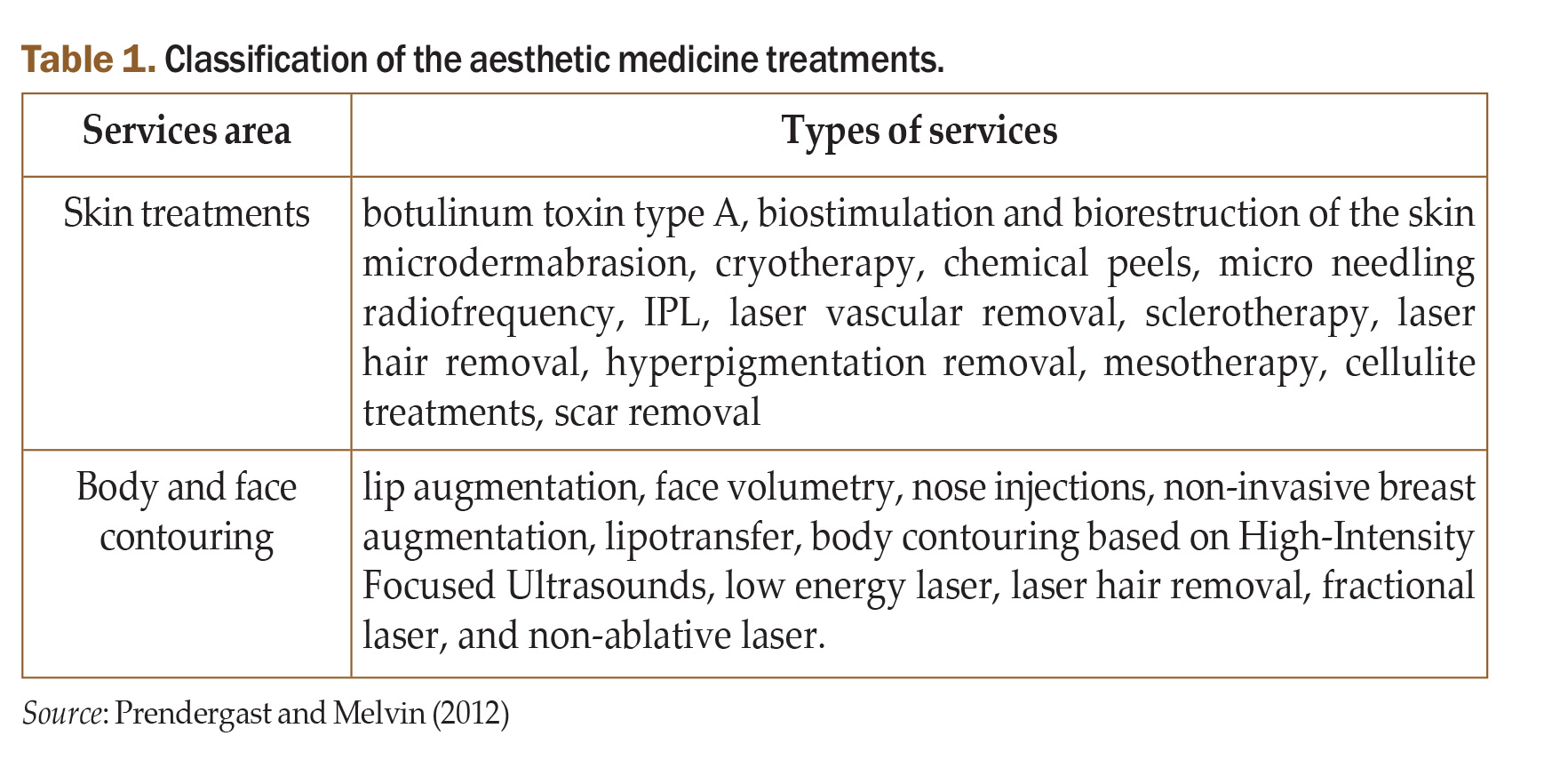
The number of aesthetic medicine clinics is increasingly significantly each year, driven by growing consumer interest. Non-surgical treatments, including botulinum toxin A (BoNT-A), hyaluronic acid, other dermal fillers, and laser treatments, have been the fastest-growing procedures in aesthetic medicine over the past five years (Vlahos & Bove, 2015). For instance, the use of botulinum toxin A injections has surged remarkably since their first use in this setting in the mid-1980s (Dover et al., 2018; Carruthers & Carruthers, 1998). Current aesthetic uses of BoNT-A include treating glabellar lines, forehead wrinkles, periorbital and perioral lines, platysmal bands, horizontal necklines, and the masseter muscle, among many other applications (Blitzer et al., 1993; Dorizas et al., 2014). Aesthetic medicine is a rapidly evolving field, propelled by innovative technologies and advancements in treatment materials (Przylipiak, 2017). Modern aesthetic medicine employs a wide range of lasers, energy-based devices, and natural or synthetic fillers (Redaelli & Ignaciuk, 2000). Technological progress has significantly expanded the possibilities for aesthetic treatments, transforming the delivery of skincare within clinical dermatology. In particular, the harmful effects of UV irradiation have spurred the development of therapies aimed at reversing photodamage. Among these, laser technologies have become a cornerstone of skin rejuvenation treatments (Theodorou et al., 2021).
Table 2 presents the growth in innovative aesthetic medicine services since 1965. Research papers since 2018 have highlighted the introduction of the newest technology, High-Intensity Focused Electromagnetic Field (HIFEM) used in body contouring and urinary incontinence treatments, and address the safety and effectiveness of this technology (Jacob & Paskowa, 2018; Samuels, 2018; Samuels et al., 2019). A variety of technologies and less invasive methods to treat a wide range of beauty defects and difficulties in daily life are constantly being improved. The advancement of medical technology, the provision of professional services, and the functional training of aesthetic medical practitioners all significantly contribute to the profitability of enterprises in this field (Skountridaki, 2017).
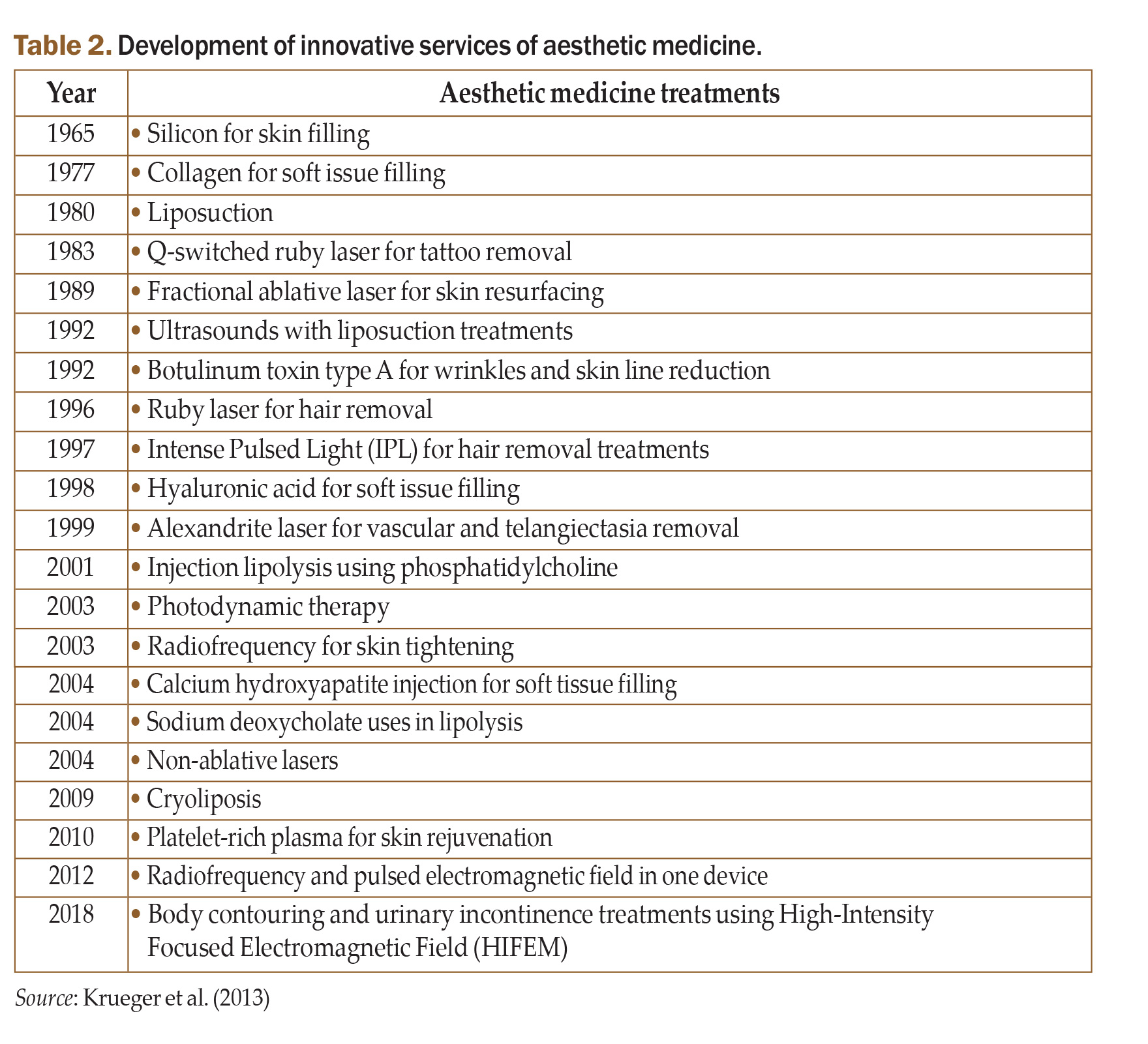
Consumer satisfaction in aesthetic medicine is understood as a psychological state in which the perceived characteristics of the product or services match consumer expectations (Hunt, 1998). In this context, patient satisfaction depends on the post-treatment effects. Many objective and sub-objective factors influence patient satisfaction, such as treatment availability, the ongoing care process, health improvements health, and service price (Małecka & Marcinkowski, 2007; Ankiel & Kuczyńska, 2018). One of the most important determinants of patient satisfaction is the experience and expertise of the medical doctor who is carrying the treatments, who should provide patients with positive emotions and a sense of safety. Patient trust, doctors’ empathy, attentive listening, and professionalism are critical factors in aesthetic medicine. Moreover, effective communication between doctor and patient provides an opportunity to thoroughly understand the patients’ concerns and fosters a sense of trust in the doctor (Bukowska-Piestrzyńska, 2017).
Patient satisfaction is a key metric for evaluating a healthcare organization’s success. In the United States, physician bonuses are linked to patients’ evaluation of their interaction with doctors (Funk et al., 2012). A variety of tools and measures have been developed to estimate patients satisfaction and evaluate specific outcomes, which are important to receiving aesthetic medicine services (Cohen & Scuderi, 2017). For instance, Likert-type scales may be used to rate patients’ satisfaction, such as the Facial Lines Treatment Satisfaction Questionnaire (Cox et al., 2003). Another instrument is the Facial Line Outcome questionnaire, which evaluates specific outcomes such as perception of attractiveness, self-perception of aging, and extended facial lies, which may project expressions such as stress, anger, or simply looking tired which the patient does not actually feel (Dayan et al., 2019). For a more objective and reproducible assessment of aesthetic procedures and patient satisfaction, the Aesthetic Numeric Analog Scale has been introduced. This scale builds on established tools such as the Wong-Baker FACES Pain Rating Scale and the 11-Point-Box-Scale to create a standardized approach (Funk et al., 2012).
The Net Promoter Score (NPS) is a versatile tool employed across various service industries, including healthcare, to gauge how likely a patient or other consumer is to recommend a service. In this framework, consumers are categorized as Promoters (those who actively recommend the services), Passives (those who are satisfied, but do not actively recommend the services); and Detractors (consumers who actively discourage others from using the services) (Reichheld, 2003). NPS is increasingly being used to measure patient satisfaction , serving as a simple yet effective indicator of overll cosumer experience.
One notable application of NPS is the Family and Friends Test, widely used by the National Health Services (NHS) of the United Kingdom to measure overall patient satisfaction and likelihood of recommendation (Stirling et al., 2013; Wilberforce et al., 2019). The straightforward and unambiguous nature of the NPS methodology has contributed to its growing popularity in consumer satisfaction studies, often outperforming alternative models like SERVQUAL or SERVPERF in terms of usability and ease of interpretation (Parasuraman et al., 1985; Cronin & Taylor, 1992).
However, while NPS and similar tools have been extensively studied and applied in fields like plastic surgery, dentistry, and orthodontics (De Vries et al., 2014; Sharp et al., 2014; Abbas & Karadavut, 2017), aesthetic medicine remains underexplored in the context of consumer satisfaction. Existing research on consumer behavior in healthcare highlights significant gaps in understanding the determinants of satisfaction among patients undergoing aesthetic medicine treatments and the relationship between satisfaction and loyalty of consumers/patients.
The present study, therefore, aims to identify the satisfaction indicators of the clients using innovative aesthetic medicine services based on innovative technologies. Evaluating client satisfaction in this context will enable a more precise identification of patient expectations, allowing practitioners to better align their offerings with client needs.
3. Materials and methods
The research process was structured in two stages, combining both quantitative and qualitative methods to ensure a comprehensive analysis of satisfaction indicators among clients and practitioners of aesthetic medicine services.
Stage 1: quantitative survey
The first stage involved a quantitative survey conducted through direct interviews at aesthetic medicine clinics located in selected large cities in Poland (with more than 500,000 inhabitants) – Poznań, Kraków, Warsaw, Łódź and Gdynia – in the period from May to June 2019. As a research tool, we used a direct interview questionnaire prepared and verified in piloting. The research population included consumers declaring regular use of aesthetic medicine services. The research sample included 745 respondents; the selection of respondents was based on purposive sampling (Tongco, 2007). The reliability of the construction of the questionnaire was verified using the Alpha-Cronbach test (the coefficient was 0.81, indicating good reliability).
Two crucial aspects of the research are worth emphasizing (Ankiel et al., 2021):
- the distinctive research site: large aesthetic medicine clinics in the above-mentioned cities (each with more than 500 patients in their client bases),
- the significant size of the research sample composed of patients of these clinics (n=745).
A review of the existing literature shows that there have been relatively few comparable research attempts in aesthetic medicine, mainly due to the difficulties of obtaining consent for participation of the patients in a direct questionnaire. These challenges arise from the very personal nature of the procedures and the sensitive reasons for their implementation (Angelini & Carmignani, 2017; Betancur et al., 2014).
Stage 2: qualitative survey
The second stage involved a qualitative survey conducted among aesthetic medicine doctors. This phrase aimed to identify the key determinants influencing the development of treatment offerings in aesthetic medicine. The survey was carried out in August 2019, among physicians attending the XXI 5 Continent – Congress Barcelona, and in September 2019, among attendees of the XX International Congress of the Polish Society of Aesthetic Medicine and Anti-Aging in Warsaw. The research sample included 20 respondents – doctors from Poland, the United States, and Spain. Individual in-depth interviews (IDIs) were conducted using a pre-tested direct interview questionnaire to explore the perspectives of medical professionals.
The satisfaction survey of patients using aesthetic medicine services in Poland was carried out using the Net Promoter Score technique.
4. Results and discussion
4.1. Identification the most popular innovative aesthetic medicine treatments
Continuous technological advances and the evolution of aesthetic medicine techniques have significantly expanded the options available to patients, enabling the use of non-invasive or minimally invasive techniques to improve the external appearance and address signs of skin and body aging. The primary goals driving modern aesthetic medicine are to reduce the invasiveness of treatments and shorten the recovery time while maintaining the best possible results.
Striving to meet evolving trends in consumer expectations, manufactures of Energy Based-Devices (EBDs) are continually introducing innovative technologies. Among the latest technologies to be introduced into the aesthetic medicine market is the High-Intensity Focused Electromagnetic Field (HIFEM). In Poland, distribution of HIFEM devices began in 2019. HIFEM is used for body contouring treatments and treating urinary incontinence (Jacob & Paskowa, 2018). Owners of aesthetic medicine clinics and medical doctors can choose among various medical devices and fillers, and other injection materials. However, the wide array of available equipment and materials poses challenges in creating the most effective and appealing service offerings. The selection process requires careful consideration of consumer preferences, market trends, and the specific benefits of each technology. The most popular aesthetic medicine services in medical doctors’ opinions are shown in Table 3.
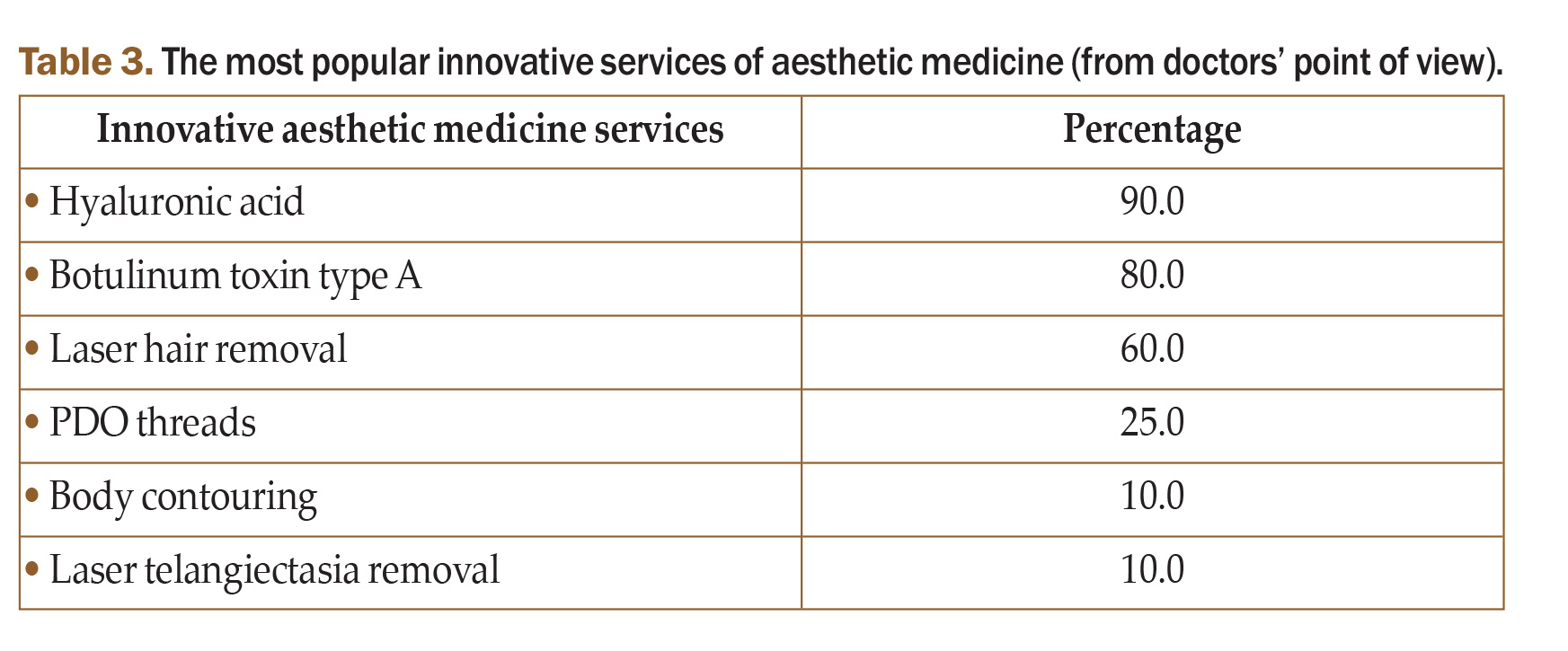
The most popular aesthetic medicine services selected by medical doctors is hyaluronic acid treatment. Hyaluronic acid is commonly used to fill the wrinkles, giving the client/patient a younger and smoother skin surface. It is also used to enhance the volume of the cheeks and to augment the lips. Its popularity is largely due to the low percentage of post-treatment complications. Other fillers, such as autologous fat tissue or collagen, cause post-treatment complications more often (Carruthers & Carruthers, 2011).
The second most popular aesthetic medicine treatment indicated by medical doctors is botulinum toxin type A injections – one of the most widely used treatments for reducing signs of skin aging. BoNT-A works by inhibiting the secretion of acetylcholine, leading to the relaxation of the facial muscles and making the face appear smoother and younger (Baumann et al., 2016). Additionally, neurologists use it to treat migraine headaches.
The third most popular aesthetic treatment services is laser hair removal (60% of indications by the medical doctors). Laser hair removal is based on selective thermolysis, which targets melanin in the hair to produce a localized thermal effect, damaging the hair follicle and stopping hair growth (Lanigan, 2000). This treatment provides satisfactory post-treatment outcomes.
Next most frequently, medical doctors selected PDO thread treatments (25% indications). PDO threads are applied under the face skin, providing a revitalizing and lifting effect (Przylipiak, 2017). The least popular aesthetic medicine treatment, as indicated by the physicians, is laser telangiectasia removal (with only 10% indications). However, despite its lower popularity, this treatment remains the only effective option for addressing flushing – an involuntary or temporary reddening of the face, neck, and décolletage caused by factors such as temperature changes, physical activity, or consuming hot and spicy foods – and telangiectasia, which involves the chronic dilation of small blood vessels, resulting in visible dark red or light red blotches on the skin.
The popularity of innovative aesthetic medicine services as ranked by the patients surveyed, on the other hand, is shown in Table 4.
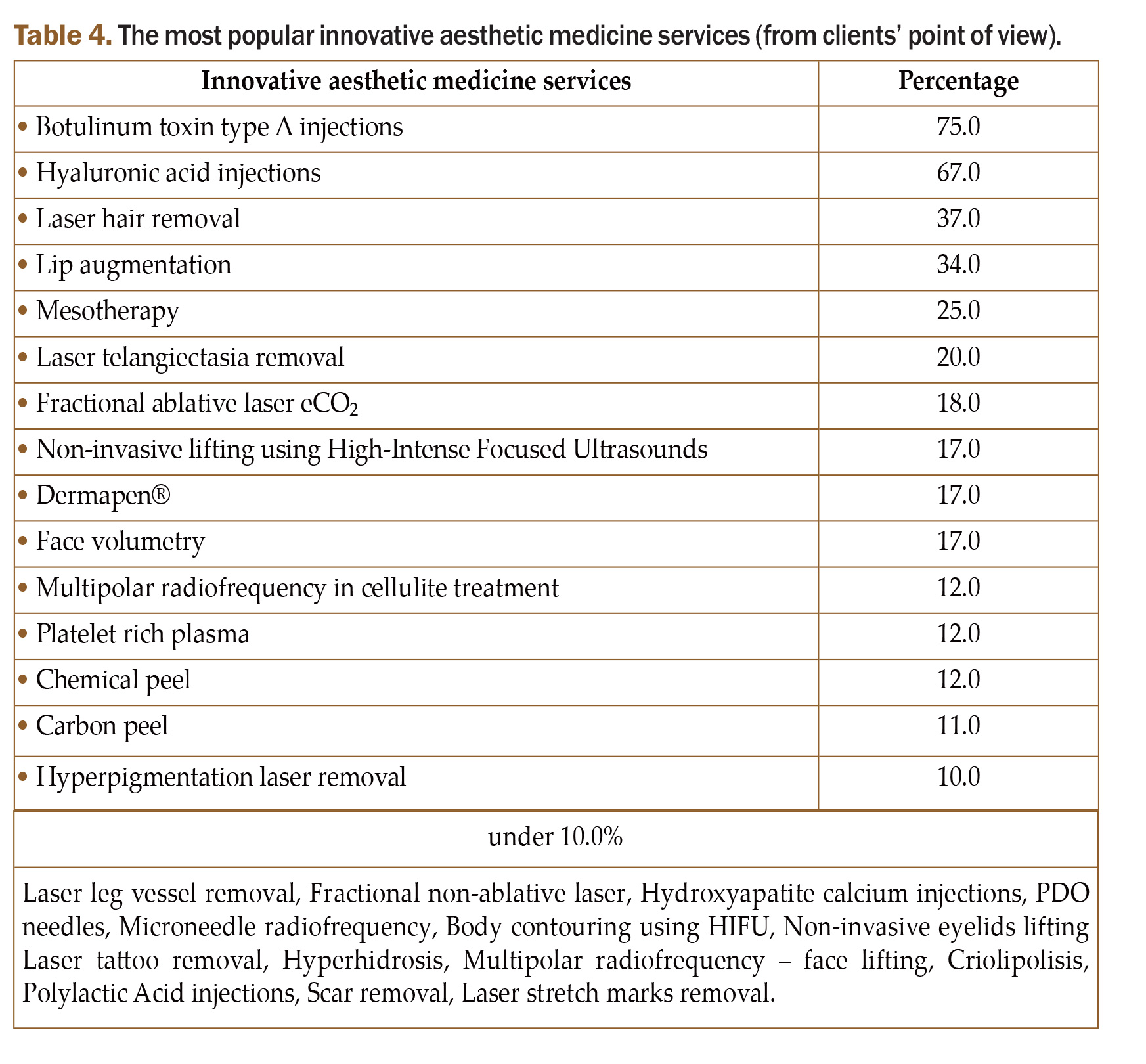
Based on patient responses, botulinum toxin type A injections (75% indications) are the most popular aesthetic medicine treatment. This is followed closely by procedures based on hyaluronic acid injections (67% indications). The third most popular selection is laser hair removal (37% indications), with lip augmentation ranking next (34% indications). While this latter service is typically performed by using hyaluronic acid, doctors might also apply collagen or silicon.
The next innovative treatment in the patients’ ranking is microneedle mesotherapy (25% indications). This treatment has gained its popularity due to its versatility in treating various conditions, such as alopecia or selected skin inflammations (Jager et al., 2011). Ranking next are laser telangiectasia removal (20% indications) and fractional ablative laser eCO2 (18% indications). The fractional ablative laser is particularly notable for its effectiveness in scar removal and skin resurfacing. This treatment works by damaging targeted areas of the skin to stimulate the repair process, which shortens collagen fibers and results in smoother, more delicate skin (Alexiades-Armenakas et al., 2008). Despite being one of the most invasive treatments in aesthetic medicine, it remains a highly rated and sought-after service.
The next most popular aesthetic medicine treatments are High Intensity Focused Ultrasounds and Dermapen® treatment and face volumetry (both with 17% indications). Contemporary High Intensity Focused Ultrasounds (HIFU) is one of the most effective methods of non-invasive skin lifting. This treatment’s main aim is to provide to focused thermal damage in deep layers of the skin or fat tissue (Wasiluk, 2007). Dermapen®, in turn, is a treatment that uses superficial skin needling to start skin self-recovery (Hou et al., 2017). Volumetry treatment gives increasing volume to tissues in the checks, jawline, etc. (Baumann et al., 2016). Other treatments were indicated by less than 15% of respondents and were therefore not included in this analysis.
In summary, aesthetic medicine treatments incorporating innovative techniques such as laser therapy and HIFU are very popular due to their fast post-treatment effects and minimal recovery time. The findings of this part of the present study may be invaluable for medical doctors and the owners of aesthetic medicine clinics in shaping their service offerings to better align with patient preferences and expectations.
4.2. Aesthetic medicine services – consumer satisfaction
This study study aimed to evaluate the satisfaction of patients receiving aesthetic medicine treatments based on innovative technologies, performed at aesthetic medicine clinics in large Polish cities. Figure 1 shows the extent to which post-treatment effects complied with patient expectations.
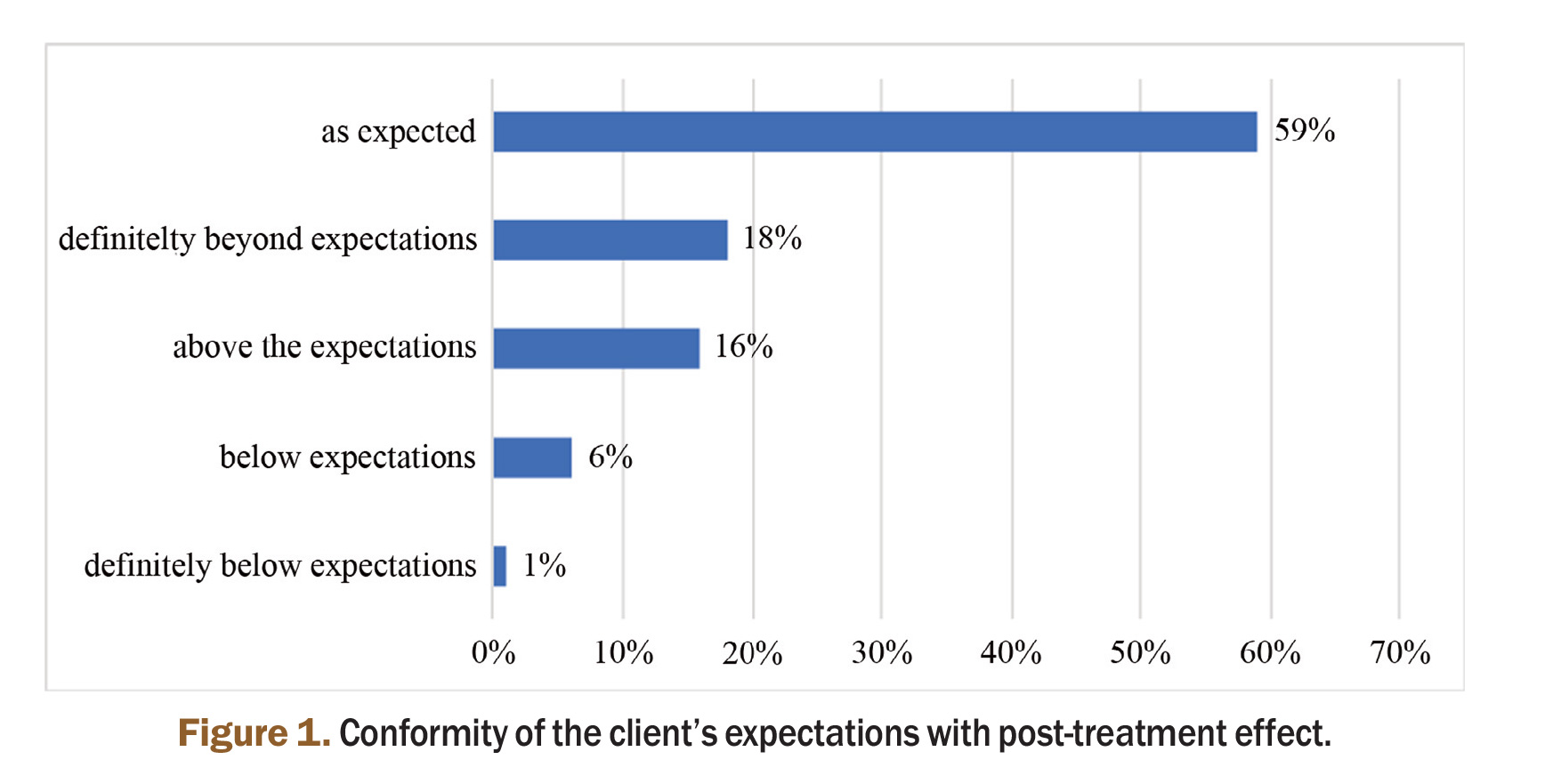
Most of the respondents making use of aesthetic medicine services in large cities in Poland positively assessed the adequacy of those services in meeting their expectations (59% reported that the service was as expected, 16% that it was above their expectations, and 18% that it exceeded significantly beyond their expectations) (Fig. 1). Respondents highlighted such aspects as the clinic’s prestige, its range of facilities (devices and fillers), positive energy, and the quality of the information provided by the clinic. Addressing any post-treatment complications was also deemed crucial, as it enhances patients’ sense of safety (Ankiel et al., 2021). About 6% of respondents indicated that the post-treatment effects were below their expectations, while only 1% indicated that they fell significantly below their expectations.
In this context, it is important to stress that the main contraindication for all aesthetic medicine services is having unreal expectations. Sometimes, the patient’s expectations may be simply impossible to meet. Moreover, in some cases, the patient’s state of health may preclude certain medical procedure from being carried out.
In summary, a majority of respondents were found to be pleased with the outcomes of aesthetic medicine services. Treatments that align with or exceed patient expectations positively influence satisfaction, enhance quality of life, and contribute to better overall well-being. Hence, addressing both procedural outcomes and the holistic patient experience is key to maintaining high levels of satisfaction in aesthetic medicine services.
The main objective of this study was to identify the level of patient satisfaction with aesthetic medicine services rendered in Poland. Additionally, the study assessed the role of clinics as significant determinants in the development of the aesthetic medicine market. It is noteworthy that this study is one of the few large-scale surveys conducted in Poland targeting a broad group of aesthetic medicine clients through direct questionnaire interviews, carried out shortly before the COVID-19 pandemic.
As mentioned earlier, the Net Promoter Score (NPS) methodology was employed for this assessment. In accordance with the NPS procedure, clients of aesthetic medicine clinics were first asked about the likelihood of their recommending the treatments to their friends. Subsequently, respondents were asked about their likelihood of recommending the specific clinic to potential clients. Recommendations were rated on a 0–10 scale, reflecting the level of likelihood. The results for the first issue, analyzed across the general population and various age groups, are presented in Table 5. Gender analysis was excluded due to the relatively small representation of male respondents (12% of the total).
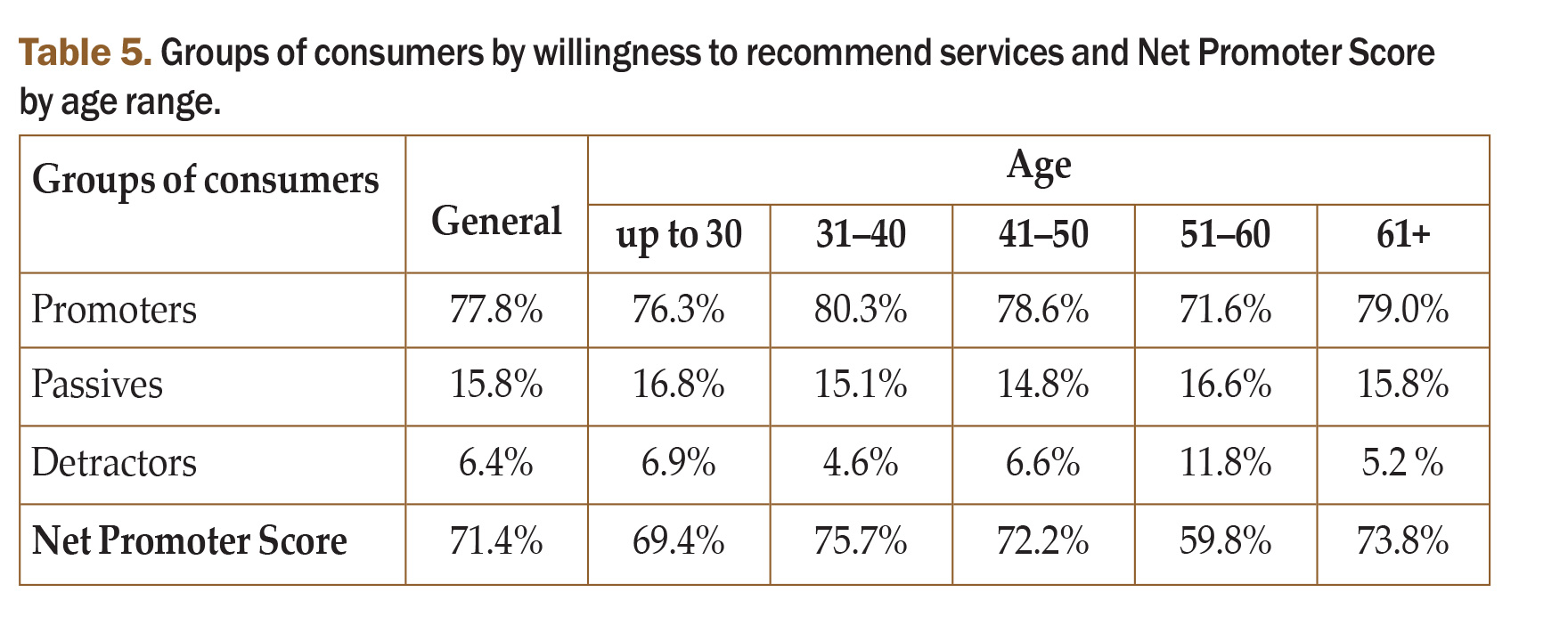
The results in Table 5 show a clear dominance of the Promoters group across all age categories, with values exceeding 70% in every subgroup. This indicates a high likelihood of respondents recommending aesthetic medicine treatments (scored 9 or 10). Conversely, the proportion of Detractors is remarkably low, never exceeding 7%, except for the 51–60 age group, where it slightly increased to 11.8%.
The overall NPS score for the entire population reached 71.4%, reflecting a very positive evaluation and high satisfaction with aesthetic medicine services in Poland. The NPS score was even higher among respondents aged 41–50, exceeding 75%. These findings suggest a consistently high level of consumer satisfaction with aesthetic medicine services, regardless of the patients’ age. Additionally, the results indicate a promising outlook for the growth of aesthetic medicine services in Poland in the coming years.
The study also explored the likelihood of respondents recommending the specific aesthetic medicine clinics they had utilized. These results, presented in Table 6, closely align with the general recommendations for aesthetic medicine treatments. The overall NPS score for clinics was 77.1%, reflecting a high probability of recommendation. This value remained consistently high across all age groups, with a slightly lower score observed in the 51+ age group.
These findings reinforce the conclusion that both treatments and specific clinics offering aesthetic medicine services in Poland are highly regarded by consumers, underscoring the importance of maintaining high service quality and customer satisfaction to drive market growth.
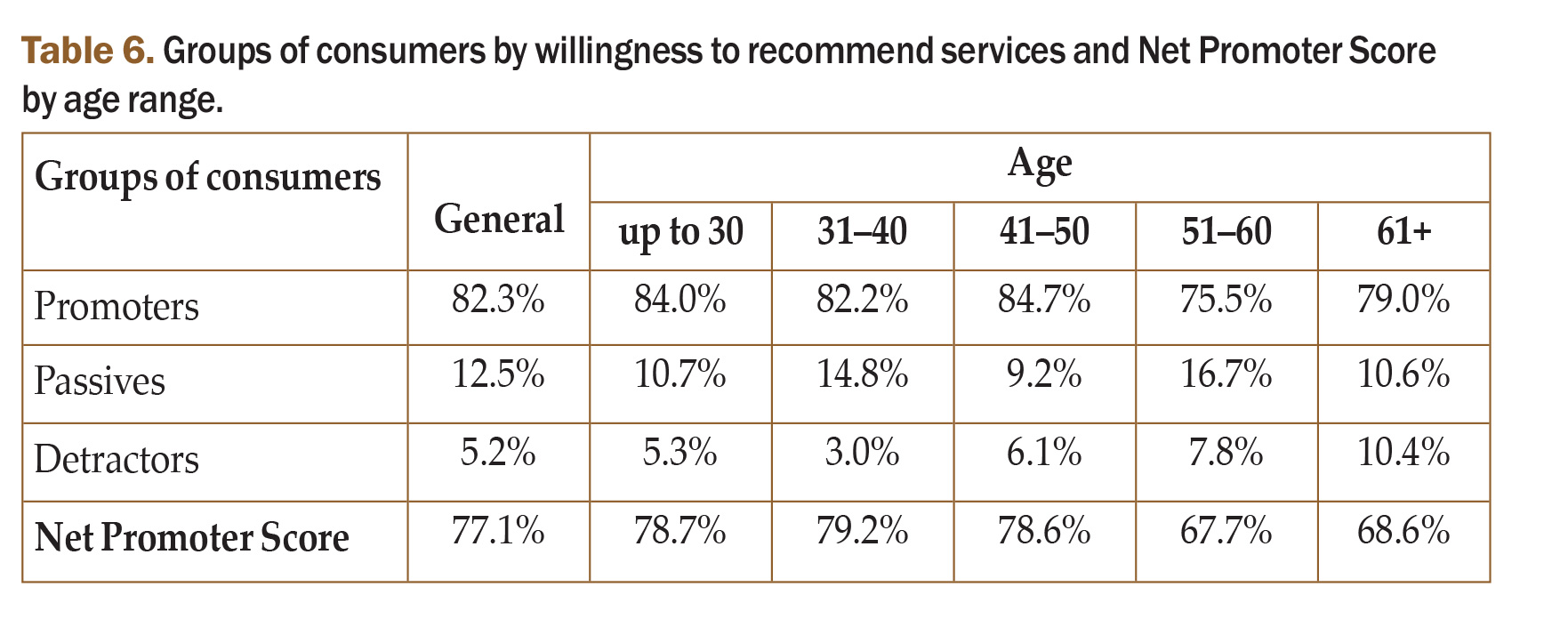
5. Conclusions
The theoretical and empirical literature offers numerous studies on patient satisfaction with medical services, but they mainly focus on aspects related to the patient’s attitude, nurses, emergency room service, or general healthcare staff. Many studies specifically explore plastic surgery services and factors determining patient satisfaction with this type of services, such as clear explanations of problems/conditions, addressing patient questions/worries, involvement in decision-making, information about medications, follow-up care instructions, the use of clear language, the time clinicians spend with the patient, etc. (Clapham et al., 2010; Chen et al., 2018). Aesthetic medicine, being a much younger field of study compared to plastic surgery, has had relatively few studies assessing patient satisfaction.
In Poland, our own study was one of the first to examine patient satisfaction with services offered by aesthetic medicine clinics (Ankiel & Kuczyńska, 2018). However, given the very similar nature of the outcomes achieved by aesthetic medicine and plastic surgery procedures – such as appearance enhancement and the correction of natural defects – based on our findings, it can be assumed that the sets of determinants of patient satisfaction are largely similar across both fields. On the other hand, satisfaction surveys for services provided in offices and clinics must take into account specific factors such as location, decor, equipment quality, professionalism of medical staff, and the level of patient care and service.
More broadly, the present findings support the conclusion that the aesthetic medicine market in Poland is poised for strong growth, both in terms of the number of procedures performed and the overall value of the services provided. The high level of patient recommendations reflects the exceptional quality of aesthetic medicine services available in Poland: the satisfaction levels reported by respondents differ significantly from those observed in other medical services in the country. This is particularly notable given that the overall evaluation of healthcare services in Poland is often considered relatively low compared to other European Union countries.
The present study has a number of practical implications. First of all, it shows that a professional approach to patient care and the delivery of high-quality treatments and accompanying processes are essential for achieving patient satisfaction. In Poland, aesthetic medicine is characterized by high satisfaction ratings, whereas other types of medical services are generally evaluated as being of low satisfaction and poor quality. We believe that this derives from the fact that these services are predominantly provided by private offices and aesthetic medicine clinics. From the marketing point of view, therefore, it is important to build positive relationships with patients before, during, and after each procedure, which results in very positive WOM (word of mouth), necessary for increasing the demand for this type of service. Moreover, in the private sector, implementing innovative technologies as part of various types of treatments is typically a short and simple process (usually with a single decision-maker). Offering cutting-edge treatments is another dimension important for building a positive image and reputation for an office or clinic.
Despite its potential for growth, however, the aesthetic medicine market in Poland faces some limitations. One significant challenge is the affordability of services; many innovative treatments represent a substantial financial burden for patients, limiting access. Moreover, intense market competition could lead to reduced prices for aesthetic medicine services in the future.
The market’s development will also be influenced by factors such as increasing household wealth and advancements in medical technology. However, the lack of public education on aesthetic medicine, particularly in rural areas, and the absence of reimbursement for such services from the state healthcare system are additional barriers.
Further research by the authors of the present study will focus on examining the determinants of consumer satisfaction in aesthetic medicine services in international markets, with a particular emphasis on Western Europe, Turkey, the United States, and Brazil.
References
Abbas, O. L., & Karadavut, U. (2017). Analysis of the Factors Affecting Men’s Attitudes Toward Cosmetic Surgery: Body Image, Media Exposure, Social Network Use, Masculine Gender Role Stress and Religious Attitudes, Aesthetic Plastic Surgery, 41(6), 1454–1462.
Alexiades-Armenakas, M. R., Dover, J. S., & Arndt, K. A. (2008). The spectrum of laser skin resurfacing: Nonablative, fractional, and ablative laser resurfacing, Journal of the American Academy of Dermatology, 58(5), 719–737.
Angelini, A., & Carmignani, G.G. (2017). The consumer experience of aesthetic medicine services. In 20th Excellence in Services International Conference, Conference Proceedings (pp. 11–22), University of Verona.
Ankiel, M. & Kuczyńska, A. (2017). Wyznaczniki satysfakcji klientów korzystających z usług medycyny estetycznej, Studia Ekonomiczne. Zeszyty Naukowe Uniwersytetu Ekonomicznego w Katowicach, 330, 7–15.
Ankiel, M., Sojkin B., & Gogołek A. (2021). Determinants of purchasing decisions of innovative aesthetic medicine services in Poland, International Journal of Innovation and Learning, 29(3), 373–386.
Asscher, E.C. (2014). Wish-fulfilling medicine in practice: opinions and arguments of lay people, Journal of Ethics, 40(12), 837–841.
Baumann, L., Dayan, S., Connolly, S., Silverberg, N., Lei, X., Drinkwater, A., & Gallagher, C. J. (2016). Duration of Clinical Efficacy of OnabotulinumtoxinA in Crow’s Feet Lines, Dermatologic Surgery, 42(5), 598–607.
Betancur, D. M., Castaneda, K.M., & Tavera-Mesias, J. (2014). Correlational study of the factors that influence in the recommendation and loyalty of patients of aesthetic medicine Medellín Colombia, Cuadernos de Administracioìn Journal of Management, 33(58), 3–17.
Blitzer, A., Brin, M. F., Keen, M. S., & Aviv, J. E. (1993). Botulinum Toxin for the Treatment of Hyperfunctional Lines of the Face, Archives of Otolaryngology – Head and Neck Surgery, 119(9), 1018–1022.
Boon, K., & Tan, H. (2007). Aesthetic medicine: a health regulator’s perspective, Clinical Governance: An International Journal, 12(1), 13–25.
Brody, H.J., Monheit, G.D., Resnik, S.S., & Alt, T.H. (2000). A history of chemical peeling, Dermatologic Surgery, 26(5), 405–409.
Bukowska-Piestrzyńska, A. (2017). Quality of Medical Services – Based on the Example of Dental Services, Problemy Jakości, 6, 8-16.
Carruthers, J., & Carruthers, A. (1999). Practical Cosmetic Botox Techniques. Journal of Cutaneous Medicine and Surgery, 3(4_suppl), S4–49–S4–52.
Chen, K., Congiusta, S., Nash, I. S., Coppa, G. F., Smith, M. L., Kasabian, A. K., Tanna, N. (2018). Factors Influencing Patient Satisfaction in Plastic Surgery, Plastic and Reconstructive Surgery, 142(3), 820–825.
Chistobaev, A. I., & Semenova, Z. A. (2018). Spatio-Temporal Dynamics of the Global Medical Tourism, Journal of Environmental Management & Tourism, 9, 267–75.
Clapham, P. J., Pushman, A. G., & Chung, K. C. (2010). A Systematic Review of Applying Patient Satisfaction Outcomes in Plastic Surgery, Plastic and Reconstructive Surgery, 125(6), 1826–1833
Cohen, J. L., & Scuderi, N. (2017). Safety and Patient Satisfaction of AbobotulinumtoxinA for Aesthetic Use: A Systematic Review, Aesthetic Surgery Journal, 37(suppl_1), 32–44.
Cox, S.E., Finn, J.C., Stetler, L., Mackowiak, J., & Kowalski, J.W. (2003). Development of the Facial Lines Treatment Satisfaction Questionnaire and initial results for botulinum toxin type A-treated patients, Dermatologic Surgery, 29(5), 444–459.
Cronin, J. J., & Taylor, S. A. (1992). Measuring Service Quality: A Reexamination and Extension, Journal of Marketing, 56(3), 55–68.
Dayan, S., Yoelin, S. G., De Boulle, K., & Garcia, J. K. (2019), The Psychological Impacts of Upper Facial Lines: A Qualitative, Patient-Centered Study, Aesthetic Surgery Journal Open Forum, 1(2).
De Vries, D., Jochen, P., Nikken, P., & de Graaf, H. (2014). The Effect of Social Network Site Use on Appearance Investment and Desire for Cosmetic Surgery Among Adolescent Boys and Girls, Sex Roles: A Journal of Research, 71(9), 283–295
Dorizas, A., Krueger, N., & Sadick, N. S., (2014). Aesthetic Uses of the Botulinum Toxin, Dermatologic Clinics, 32(1), 23–36.
Dover, J. S., Monheit, G., Greener, M., & Pickett, A. (2018). Botulinum Toxin in Aesthetic Medicine, Dermatologic Surgery, 44(2), 249–260.
Funk, W., Podmelle, F., Guiol, C., & Metelmann, H. R. (2012). Aesthetic satisfaction scoring – Introducing an aesthetic numeric analogue scale (ANA-scale), Journal of Cranio-Maxillofacial Surgery, 40(5), 439–442.
Grand View Research (2024). Aesthetic Medicine Market Size, Share & Trends Analysis Report By Procedure Type (Invasive Procedures, Non-invasive Procedures), By Region (North America, Asia Pacific, Europe), And Segment Forecasts, 2024-2030. Grand View Research.
https://www.grandviewresearch.com/industry-analysis/medical-aesthetics-market.
Hou, A., Cohen, B., Haimovic, A., & Elbuluk, N. (2017). Microneedling, Dermatologic Surgery, 43(3), 321–339.
Hunt, H. K. (1991). Consumer Satisfaction, Dissatisfaction, and Complaining Behavior, Journal of Social Issues, 47(1), 107–117.
Jacob C.I., Paskowa K. (2018). Safety and efficacy of a novel high-intensity focused Electromagnetic technology device for non-invasive abdominal contouring, Journal of Cosmetic Dermatology, 17, 783–787.
Jäger, C., Brenner, C., Habicht, J., & Wallich, R. (2011). Bioactive reagents used in mesotherapy for skin rejuvenation in vivo induce diverse physiological processes in human skin fibroblasts in vitro ‒ a pilot study, Experimental Dermatology, 21(1), 72–75.
Krueger N., Luebberding S., Sattler G., Hanke C.W., Alexiades-Armenacas M., Sadick N. (2013). The History of Aesthetic Medicine and Surgery, Journal of Drugs in Dermatology, 7(7), 737–742.
Lanigan, S. W. (2000). Lasers in dermatology. Springer.
Liao, K., Chen, S., & Jhou, Y. (2019). An exploration of factors influencing the potential customers perceived value in aesthetic medicine, Commerce & Management Quarterly, 20(2), 109–130.
Lin, T. T., & Yen, H.-T. (2020). The Criteria of Optimal Training Cost Allocation for Sustainable Value in Aesthetic Medicine Industry, Journal of Risk and Financial Management, 13(7), 149.
Małecka, B., & Marcinkowski, J.T. (2007). Satysfakcja pacjenta czynnikiem kształtującym współczesny rynek usług medycznych, Problemy Higieny Epidemiologicznej, 88(1), 17–19.
Napiwodzka-Bulek, K. (2017). Medycyna estetyczna – humanistyczne dążenie czy „enhancement”? Filozofia Publiczna i Edukacja Demokratyczna, 6(1), 151–166.
Parasuraman, A., Zeithaml, V. A., & Berry, L. L. (1985). A Conceptual Model of Service Quality and Its Implications for Future Research, Journal of Marketing, 49(4), 41–50.
Pfenninger, J. L., & Fowler, G. C. (2011). Pfenninger and Fowler’s procedures for primary care (2nd ed.). Elsevier/Saunders.
Posełek, M. (2024, August 4). Ile jest wart rynek medycyny estetycznej? Fashion Biznes. https://fashionbiznes.pl/wartosc-rynku-medycyny-estetycznej-ile-wynosi/
Prendergast, P.M., & Shiffman, M.A. (2012). Aesthetic medicine: Art and techniques, Springer.
Przylipiak, A. (2017). Medycyna Estetyczna: Podręcznik dla studentów kosmetologii. Wydawnictwo Lekarskie PZWL.
Pustułka, A., & Jędrzejczak, A. (2018, October 14). Medycyna estetyczna to duży biznes. Chcemy być coraz piękniejsi. Retrieved from https://plus.dzienniklodzki.pl/medycyna-estetyczna-to-duzy-biznes-chcemy-byc-coraz-piekniejsi/ar/13601996
Redaelli, A., & Ignaciuk, A. (2000). Medycyna Estetyczna. Wydawnictwo Medycyna Estetyczna.
Reichheld, F.F. (2003). The one number you need to grow, Harvard Business Review (81), 46–55.
Rymkiewicz, D. (2018). Relevance of information and contractual modality of aesthetic medicine: A comparative analysis between Spanish and Polish case-law. Review of European and Comparative Law, 35(4), 103–111.
Samuels J.B. (2018). Nonsurgical Vaginal Rejuvenation. In G. H. Branham, J. S. Dover, H. J. Furnas, M. M. J. Tenenbaum, & A. E. Wulc (Eds.), Advances in Cosmetic Surgery (Vol. 1, pp. 75–84). Elsevier.
Samuels, J. B., Pezzella, A., Berenholz, J., & Alinsod, R. (2019). Safety and Efficacy of a Non-Invasive High-Intensity Focused Electromagnetic Field (HIFEM) Device for Treatment of Urinary Incontinence and Enhancement of Quality of Life, Lasers in Surgery and Medicine, 51(9), 760–766.
Sharp, G., Tiggemann, M., & Mattiske, J. (2014). The role of media and peer influences in Australian womens’ attitudes towards cosmetic surgery, Body Image, 11(4), 482–487
Skountridaki, L. (2017). Barriers to business relations between medical tourism facilitators and medical professionals, Tourism Management, 59, 254–266.
Stirling, P., Jenkins, P.J., Clement, N.D., Duckworth, A.D., & McEachan, J.E. (2019). The Net Promoter Scores with Friends and Family Test after four hand surgery procedures, Journal of Hand Surgery, 44(3), 290–295.
Theodorou, S.J., Chia, Ch.T., & Dayan, E. (2021). Emerging technologies in face and body contouring. Thieme Medical Publishers.
Tongco D. C., (2007). Purposive sampling as tool for informant selection, Ethnobotany Research and Applications, 5, 147–158.
Vlahos, A., & Bove, L. L. (2016). Went in for Botox and left with a rhinoplasty Marketing Intelligence & Planning, 34(7), 927–942.
Wasiluk, M. (2016). Medycyna estetyczna bez tajemnic. Wydawnictwo Lekarskie PZW.
Welsh, W. (2005). Estetyka poza estetyką: o nową postać estetyki. Towarzystwo Autorów i Wydawców Prac Naukowych ‘Universitas’.
Wilberforce, M., Poll, S., Langham, H., Worden, A., & Challis, D. (2018). Measuring the patient experience in community mental health services for older people: A study of the Net Promoter Score using the Friends and Family Test in England, International Journal of Geriatric Psychiatry, 34, 31–37.
Załuski, K. (2023, November 28). Mężczyźni w gabinecie medycyny estetycznej. Co poprawiają i ile to kosztuje? Onet – Jesteś na bieżąco. https://www.onet.pl/styl-zycia/facet-xl/mezczyzni-w-gabinecie-medycyny-estetycznej-co-poprawiaja-i-ile-to-kosztuje/jjm64np,30bc1058
Magdalena Ankiel – Professor at the Poznań University of Economics and Business. She is employed in Product Marketing Department at the Institute of Marketing. Her research and teaching interests concern on the areas of consumer behaviour, innovation design and development and informational value of packages. She is an author of several scientific papers and books. She has experience in product management and packaging innovation projects implemented for companies.
Anna Kuczyńska – A PhD in Management, specializing in Management and Quality Sciences, is also a qualified cosmetologist. Currently a medical student. In her academic and professional work, she focuses on aesthetic medicine services, particularly the implementation of modern technological solutions in aesthetic medicine.

